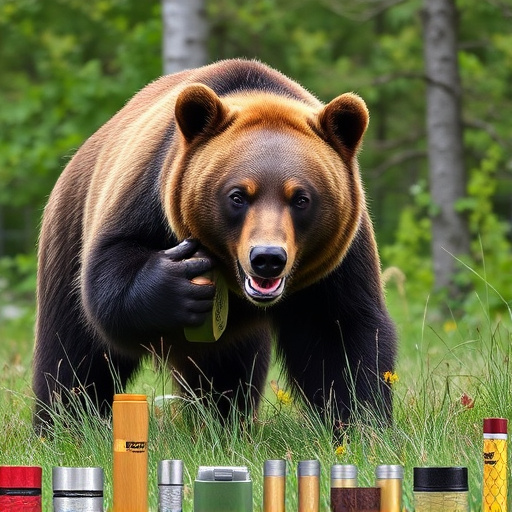Pepper spray is an effective bear defense tool using capsaicin to create a burning sensation, temporarily blinding and disorienting the animal for 20-60 seconds (duration varies based on conditions). Understanding this period is crucial for safe retreat. Its effectiveness relies on disrupting the bear's sensory perception, but can be shorter if the bear becomes agitated or longer in humid conditions. Storage in sealed containers away from light, heat, and humidity maintains potency. Proper usage involves aiming at facial receptors, following safety measures, and considering professional training for calm encounters.
“Discover the power of outdoor bear attack prevention spray, a crucial tool in safeguarding adventurers and outdoor enthusiasts. This comprehensive guide explores the effectiveness of pepper spray as a deterrent against aggressive bears, delving into the science behind its contaminant duration. We examine factors influencing spray longevity, offering best practices and safety measures for optimal use. Understanding how long pepper spray contaminates can mean the difference between a safe hike and a life-altering encounter.”
- Understanding Pepper Spray: An Effective Bear Deterrent?
- The Science Behind Pepper Spray's Contaminant Duration
- Factors Affecting the Longevity of Outdoor Bear Attack Prevention Spray
- Best Practices and Safety Measures for Using Bear Spray
Understanding Pepper Spray: An Effective Bear Deterrent?
Pepper spray, a popular choice for personal defense against bears, is designed to incapacitate and deter aggressive behavior. It contains capsaicin, the same compound that makes chili peppers spicy. When sprayed into the eyes and face of a bear, it triggers a burning sensation, temporarily blinding and disorienting the animal, allowing the user time to escape.
The effectiveness of pepper spray as a bear deterrent is well-documented. Studies show that when used correctly, it can reduce bear attacks significantly. However, understanding its duration of effect is crucial. Pepper spray typically contaminates an area for several minutes, providing enough time for users to retreat safely. While the exact length varies based on factors like wind and weather conditions, it generally ranges from 20 seconds to a few minutes, after which the bear may regain its senses and continue its approach.
The Science Behind Pepper Spray's Contaminant Duration
The effectiveness of pepper spray in deterring bear attacks lies in its unique chemical composition, which disrupts the animal’s sensory perception. When sprayed, capsaicin, the active ingredient, binds to pain receptors in the bear’s eyes, nose, and respiratory system, causing temporary blindness, tears, coughing, and difficulty breathing. This overwhelming sensation prompts the bear to flee, offering precious time for escape or safety.
As for how long pepper spray contaminates a bear, it varies depending on several factors. Typically, the effects of capsaicin can last from 20 minutes to an hour, during which the bear may be disoriented and less aggressive. However, if the bear becomes agitated or stressed, the duration could be shorter, as physical reactions may mask the sensory overload. Conversely, in humid conditions or when the spray is not used correctly, the contaminant period might extend slightly longer.
Factors Affecting the Longevity of Outdoor Bear Attack Prevention Spray
The longevity of outdoor bear attack prevention spray, often based on capsaicin or pepper spray, is influenced by several factors. One key aspect is environmental conditions; extreme temperatures, both hot and cold, can degrade the active ingredients more quickly, reducing its effectiveness over time. Additionally, exposure to sunlight and moisture levels play significant roles in the spray’s durability. UV radiation from the sun can break down the chemical compounds, while high humidity or rain may dilute the concentration of the spray.
Another critical factor is how and where the spray is stored. If left unattended or exposed to direct sunlight, heat sources, or excessive moisture, its potency can diminish faster. Proper storage in sealed containers, out of direct light and heat, ensures a longer lifespan. Moreover, regular testing is essential; even if unused, the spray’s effectiveness may wane over months or years due to natural degradation processes.
Best Practices and Safety Measures for Using Bear Spray
When using bear spray, proper technique and understanding its duration are paramount for effectiveness. Aiming for the bear’s face, eyes, and nose is crucial, as this area has a high concentration of olfactory receptors. The spray creates a temporary sensory overload, deterring the bear. However, be mindful that pepper spray doesn’t contaminate the environment for an extended period; its effect on the bear typically dissipates within minutes. This quick breakdown allows bears to recover and resume normal behavior faster.
Safety measures should always be prioritized when carrying bear spray. Keep it accessible yet out of reach from children or pets. Regularly inspect the canister for any damage, ensuring it’s fully charged before heading into potential bear country. Familiarize yourself with local regulations regarding the use and carry of pepper spray, as these can vary widely. Proper training in bear spray usage is also beneficial, enabling users to remain calm and employ the spray effectively during a confrontation.
When it comes to outdoor bear attack prevention spray, understanding the science behind pepper spray’s contaminant duration is key. Factors like temperature, humidity, and application method can significantly affect how long it stays effective. While pepper spray is a valuable tool for deterring bears, proper usage and awareness of its limitations are essential for safety in wild environments. Regular refills and staying informed about local guidelines will ensure this deterrent remains reliable when facing potential bear encounters.
